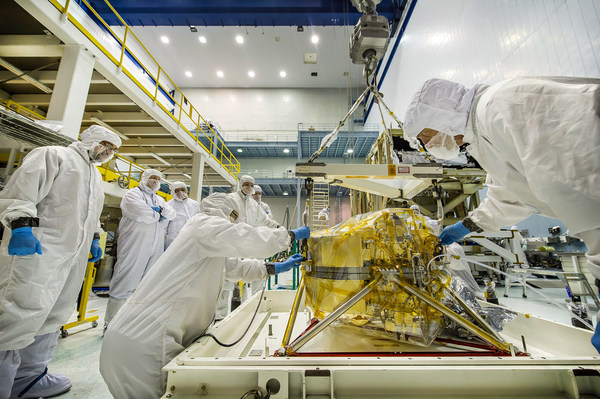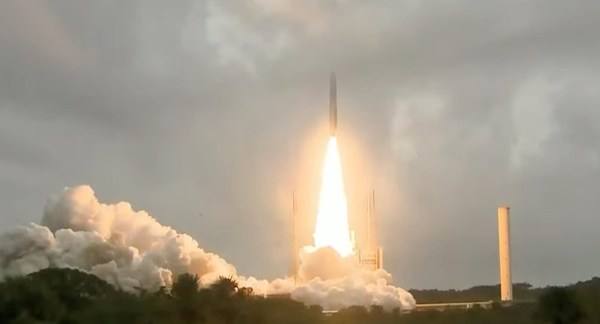27.12.2021
Launch kicked off a long journey for the $10 billion observatory.
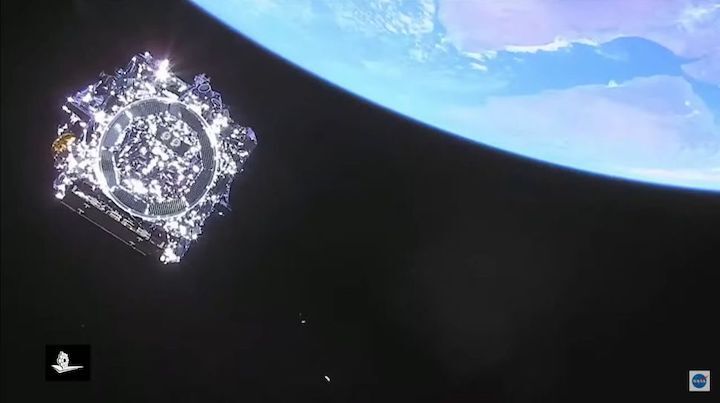
NASA's James Webb Space Telescope separates from its Ariane 5 rocket with the bright blue Earth in the background in this view captured after its launch on Dec. 25, 2021. (Image credit: NASA TV)
NASA's next big space observatory is finally aloft, but it'll be a while before it starts its highly anticipated science mission.
The $10 billion James Webb Space Telescope launched atop an Ariane 5 rocket from French Guiana yesterday (Dec. 25), kicking off a long-delayed, potentially transformative mission to study the early universe, nearby exoplanets and more. Telescope team members (and the rest of us) will have to remain patient, however, for Webb has a lot of work to do before it gets up and running.
The telescope is headed for the Sun-Earth Lagrange Point 2 (L2), a gravitationally stable spot 930,000 miles (1.5 million kilometers) from our planet in the direction of Mars. It'll take 29 days for Webb to get there, and there will be lots of nail-biting action for the telescope along the way.
"The Webb observatory has 50 major deployments … and 178 release mechanisms to deploy those 50 parts," Webb Mission Systems Engineer Mike Menzel, of NASA's Goddard Space Flight Center in Greenbelt, Maryland, said in a deployment-explaining video called "29 Days on the Edge" that the agency posted in October.
"Every single one of them must work," Menzel said. "Unfolding Webb is hands-down the most complicated spacecraft activity we’ve ever done."
Webb has notched a few major milestones already. About half an hour after liftoff, for example, it deployed its solar panels and started soaking up energy from the sun. And last night, the big telescope performed a crucial 65-minute engine burn that put it on course for L2.
The following is a brief rundown of the big steps yet to come. (For more detail, see NASA's Webb deployment site.) The timelines given are approximate; Webb team members have stressed that the deployment schedule is flexible, so don't panic if the times and dates shift a bit, or if some things occur out of order.
One day after launch, Webb will rotate its high-gain antenna toward Earth to further facilitate communications with its handlers. A day after that, the spacecraft will perform another engine burn to refine its trajectory toward L2. And three days after launch, the pallet holding Webb's huge sunshield — a five-layer structure designed to keep the infrared telescope and its instruments cool — will be lowered.
Each of the shield's five sheets is about the size of a tennis court when fully extended, far too wide to fit inside the payload fairing of any currently operational rocket. So the sunshield launched in a compact configuration and must be unfurled.
This is an incredibly complex process. The sunshield structure has 140 release mechanisms, 70 hinge assemblies, 400 pulleys, 90 cables and eight deployment motors, all of which have to work properly for the five layers to deploy as planned, NASA officials said in the video.
The protective cover will come off the sunshield at five days after launch, and its booms will extend a day later. Sunshield deployment should be complete by eight days after liftoff, at which point team members will start shifting their focus to the optics.
At around 10 days after launch, Webb will extend its 2.4-foot-wide (0.74 meters) secondary mirror, which is so named because it's the second surface that deep-space photons will hit on their way to the scope's instruments.
It will then be time for Webb's 21.3-foot-wide (6.5 m) primary mirror to shine. That mirror, which is composed of 18 hexagonal segments, launched folded up, as the sunshield did. Twelve to 13 days after launch, the mirror's two side "wings" will extend and lock into place, giving the surface its full size.
At that point, Webb will be in its final configuration. The huge observatory will arrive at its destination slightly more than two weeks later, conducting another engine burn 29 days after launch to slip into orbit around L2, where a different set of ramp-up procedures will begin.
Two to three months after launch, for instance, the team will align the primary mirror segments so they act as a single light-collecting surface. This will be painstaking and time-consuming work, for the mirror has to be perfect to an accuracy of 150 nanometers. (For perspective: A sheet of paper is about 100,000 nanometers thick.)
"One of our scientists calculated that we move those mirrors literally slower than grass grows as we're lining them up so incredibly precisely," Webb Deputy Senior Project Scientist Jonathan Gardner, of NASA's Goddard Space Flight Center in Greenbelt, Maryland, told Space.com earlier this month.
As this is happening, the team will also be testing and calibrating Webb's four scientific instruments. That will be a laborious process as well; the goal is to start regular science operations six months after launch.
"We're looking at the end of June," Gardner said.
Webb's observing time will be broken down into a variety of projects selected by peer review, as is done with NASA's Hubble Space Telescope. The first year of Webb projects has already been selected, Gardner said, so the new observatory will hit the ground running when it's ready to go.
"It's going to be a wild ride," Gardner said.
Quelle: SC
+++
James Webb Space Telescope Begins Million-Mile Journey
KOUROU, French Guiana – NASA’s James Webb Space Telescope, built in partnership with Northrop Grumman Corporation (NYSE: NOC), successfully launched today from the European Space Agency’s (ESA) Spaceport in Kourou, French Guiana aboard an Ariane 5 rocket.

Approximately 30 minutes after launch, Webb detached from the Ariane 5 rocket, marking the beginning of a million-mile journey and the start of a two-week complex deployment process to unfold the spacecraft in preparation for arrival at Lagrange Point 2 (L2).
“Since the dawn of the space age, NASA, international partner agencies and industry partners, together with Northrop Grumman, have been defining what is possible in space science and exploration,” said Kathy Warden, chairman, chief executive officer and president, Northrop Grumman. “Over the next few weeks, the James Webb Space Telescope will transform into an awe-inspiring scientific tool that will usher in a new era in human discovery.”
During the journey to L2, Webb will convert from its stowed position in which it left Earth to the configuration that will allow it to see light coming from the earliest stars to shine in the Universe. Part of this journey is to unfold the tennis court-sized, five-layer sunshield around the sensitive mirrors that allow Webb to take pictures and collect data that will come back to Earth for scientific review. Once operational, Webb will explore farther than ever before into the cosmos, looking back 13.5 billion years.

To deliver this kind of scientific data, Webb incorporates innovative design, advanced technology, and groundbreaking engineering. Ten technological inventions were created to build the revolutionary telescope so that it can detect light from the first stars and galaxies. Some of these innovations include optics, detectors and thermal control systems.
Additional James Webb Space Telescope Background for Reporters and Editors: Webb-Datasheet.pdf (northropgrumman.com)
Northrop Grumman is a technology company, focused on global security and human discovery. Our pioneering solutions equip our customers with capabilities they need to connect, advance, and protect the U.S. and its allies. Driven by a shared purpose to solve our customers’ toughest problems, our 90,000 employees define possible every day.
Quelle: Northrop Grumman
+++
NASA's James Webb Space Telescope Lifts Off With Advanced Camera From Lockheed Martin
With the liftoff of NASA's James Webb Space Telescope from French Guiana today, humankind is one step closer to seeing the universe in a whole new light, with help from a camera built by Lockheed Martin [NYSE: LMT]. The instrument will be key in giving the telescope its first glimpse of celestial light.
The Near Infrared Camera (NIRCam) is Webb's primary imager and one of the most sensitive infrared cameras ever built. As the telescope sets itself up in space, NIRCam will help align Webb's intricate array of mirrors. It will then take science images throughout the entire mission.
"NIRCam's journey is over two decades in the making, and seeing it lift off into space on Webb was the culmination of many years of hard work with Marcia Rieke and our University of Arizona partners," said Alison Nordt, Lockheed Martin's space science and instrumentation director, who led development of NIRCam. "Webb will rewrite the science books of how we understand our universe, and to have Lockheed Martin-built technology help advance the future of space imaging is an honor."
The Lockheed Martin and University of Arizona team designed, built and tested NIRCam out of the company's Advanced Technology Center in Palo Alto, California.
How to Look at the Universe's Oldest Light
Webb is designed to peer at the universe's oldest light, which scientists believe occurred around 13.5 billion years ago. As the universe expands, those light waves that were once visible have now shifted into the infrared spectrum.
This light is incredibly far away and extremely dim, which is why Webb requires large mirrors – along with NIRCam's ultra-precise optics – to see it.
Before that can happen, NIRCam's first job is to sense incoming infrared light and take images that will help the telescope's systems properly align its 18 primary mirror segments. This is critical to ensuring Webb provides crystal clear images once it enters science mode.
The Technology Behind NIRCam
For Webb's mirror alignment in early 2022, NIRCam senses what's called a "wavefront," or an ideally perfect sphere of light particles emitted from any luminescent object. When those particles encounter another object – in this case, the telescope's optics – they become distorted.
NIRCam measures those distortions with nanometric accuracy, and that data is then used to advise how Webb's mirrors must adjust. This iterative process is done until the telescope's mirrors are properly aligned.
With Webb traveling more than 1 million miles from Earth into space, NIRCam must function with extreme precision and stability in temperatures as cold as -400°F. In fact, the telescope needs frigid temperatures to ensure infrared radiating off the observatory doesn't overwhelm the images.
To enable operations in such extreme conditions, Lockheed Martin developed a new technique for bonding NIRCam's optical lenses to their mounts. The innovative method ensures the cold and launch vibrations don't cause shifts in alignment of NIRCam's lenses.
After more than a decade of meticulous engineering and rigorous testing, the team delivered one of the most capable infrared instruments ever created, and NIRCam was fully integrated onto Webb in 2014.
Now, the telescope gets situated for a decade of ground-breaking observations to shape how we see space for years to come.
More About the Mission
The Webb Space Telescope is the world's newest premier space science observatory. It will solve mysteries in our solar system, look beyond to distant worlds around other stars, and probe the mysterious structures and origins of our universe and our place in it. Webb is an international program led by NASA with its partners – the European Space Agency and the Canadian Space Agency – and industry participation from many companies, including Lockheed Martin.
Quelle: Lockheed Martin
+++

James Webb Space Telescope’s Powerful Eyes
NIRCam Will Help See the Universe in a Whole New Light
The largest, most powerful space telescope ever built – NASA’s Webb Space Telescope – will reveal what our universe looked like 13.5 billion years ago, when the first stars and galaxies took shape after the Big Bang.
Capturing those “first light” images will be the exquisitely precise Near Infrared Camera (NIRCam), one of the most sensitive infrared cameras ever built.
Engineers at Lockheed Martin’s Advanced Technology Center (ATC) in Palo Alto, California, designed, assembled and tested NIRCam, which will serve as the primary imager aboard the Webb as it travels 1 million miles into space. NIRCam is an infrared imager measuring wavelengths of light from 0.6 to 5 microns. It was created to detect the earliest star clusters and galaxies, as well as stars in nearby galaxies and young stars in the Milky Way and objects in the Kuiper Belt.
NIRCam’s Journey
The launch of Webb on Dec. 25, 2021 represents a project nearly two decades in the making. NIRCam started out in 2002, when the ATC won the contract to create the imager for principal investigator Marcia Rieke of the University of Arizona.
Lockheed Martin’s Alison Nordt was there from the beginning, starting with structural analysis for NIRCam, through duties as program manager, and now as principal engineer. “When I first came to the NIRCam program, I was just a couple years out of graduate school, a newly minted Ph.D. (in aeronautics and astronautics) eager to work on this giant space telescope,” she recalls. “I've grown up on NIRCam.”
The journey wasn’t easy at times. “I’ve been through all the bumps, challenges and triumphs along the way,” Alison says. Now, she and current Program Manager Malcolm Ferry are anxious to see NIRCam open its eyes on the universe in the months following the launch.
“We’re looking forward to all the glorious science it will create,” Malcolm says.
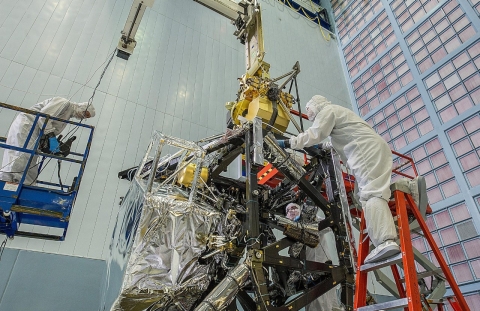
Crafting Revolutionary Designs
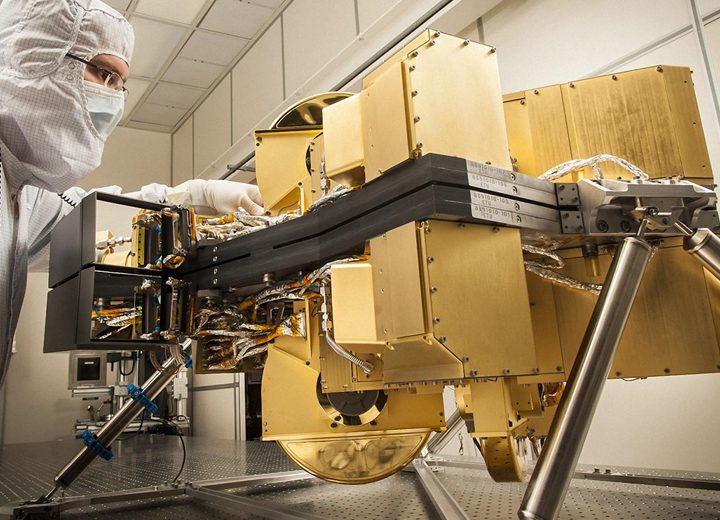
Super-Cool Tech and More
NIRCam technology has been applied to other missions. For example, the team developed methods to bond cryogenic optics that allow NIRCam to remain stable while functioning in ultracold temperatures: around 40 Kelvin, or about 150°F colder than the lowest temperature ever recorded in Antarctica.
“When we first came up with this idea, there were a lot of doubters that said, ‘you don't want to bond optics, and you really don't want to do that on a cryogenic mission,’” Alison recalls. “But we developed that technology to get extreme stability for NIRCam.”
The same mount design has flown successfully on other missions, including NASA’s Interface Region Imaging Spectrograph (IRIS), an instrument studying how energy and plasma move near the sun’s surface. “It’s an example of how we develop a technology with internal research and development that is applied to an initial program and then becomes a standard product of ours.”
More projects are underway on different scales of missions and science, from programs that look at the evolution of massive stars to monitoring the Earth’s carbon cycle. Others would revolutionize vibration isolation and precision pointing for future missions, and more projects would focus on technologies designed to build smaller, lighter-weight space telescopes.
The SPIDER (Segmented Planar Imaging Detector for Electro-optical Reconnaissance) prototype is one example. It uses a thin array of tiny lenses in place of bulky mirrors or larger lenses, potentially cutting size, weight and power needs 10 to 100 times.
Double Duty
Following launch, Webb will undergo six months of commissioning. During that period, the telescope’s 18 gold-plated hexagonal mirrors – together totaling more than 21 feet in diameter – will unfold origami-style and its tennis-court-sized sunshield will unfurl. Then, the telescope and its elements will be cooled, aligned and calibrated.
NIRCam has an important task during that commissioning period, taking initial images that will inform how to position and align the mirror’s hexagonal segments. Those first pictures won’t be Instagram-worthy, but they will be critical to making sure the mirror works once the telescope enters science mode.
With 18 segments, each with the ability to move in various directions or even change curvature, “there are a lot of ways you can tune the mirror,” Alison says. Light enters NIRCam, which uses wavefront sensing and control tools to align the mirror. “It puts a lot of responsibility on NIRCam to ensure no errors are imprinted on the primary mirror. That’s why we put so many stability and predictability requirements on NIRCam and did so much testing to ensure we understood any errors.”
Commissioning the telescope in space will take six months – what NASA calls “an exciting but harrowing time.” The ATC can help with software issues but fixing any major problems with the telescope with help from astronauts – as was the case with Hubble and a special Space Shuttle mission fix – won’t be possible. “It will be a million miles away, so we’re not going to be sending a crew up there to fix something if it doesn’t work,” Malcolm notes.
In the future as Webb completes its five- to 10-year mission, Alison, Malcolm and the ATC team will be looking out for the eye-popping science images NIRCam will produce. And while they are intrigued by the prospect of scientific discoveries, they are even more excited by the promise of mysteries and new questions the telescope and NIRCam will reveal.
Says Malcolm, “What I find most exciting is finding the things you didn’t expect to see – that’s where you learn something new. So, I’m looking forward to those surprises.”
Quelle: Lockheed Martin


